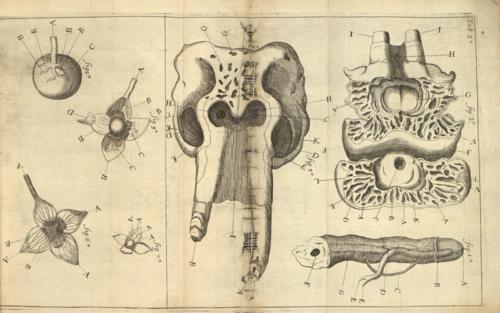I stumbled across a curious 17th century account of an elephant in Dublin city recently. Yes, you read right, an elephant. This exotic import was owned by a Mr Wilkins who kept it in a specially constructed ‘booth’ near the Custom House on Parliament Street/Essex Street. Here members of the public could view the elephant, but only after paying a significant admission price.

Unfortunately, on the night of Friday the 17th of June 1681, things went disastrously wrong for this zoological enterprise. At approximately three in the morning the wooden booth caught fire and was quickly enveloped by flames. The elephant, trapped inside, was overcome by the fire and smoke. News of the elephant’s death soon drew a large crowd of onlookers, many of whom had not been able to see the living animal due to the high admission price. It was a motley crew and things soon got out of hand. As the flames died down many of the onlookers rushed forward and attempted to carry parts of the dead animal away.
The manager, Mr. Wilkins, became alarmed as he realised there was still money to be made out of the unfortunate animal. Ever the businessman, he intended to put the elephants skeleton’s on display and he couldn’t afford to lose any of its corpse. He quickly sent for a troop of musketeers who were ordered to guard the dead animal by force arms. Work was also started on a shed to cover the elephant’s body and this was completed by 7 o’clock on the Friday evening.

Wilkins then assembled a team of butchers to de-flesh the elephant’s corpse. These were just about to commence work when Dr. Mullen arrived at 8pm. Mullen, who was a graduate of Trinity College Dublin and a member of The Royal Society, had a keen interest in anatomy. Unsurprisingly he wanted to carry out a far more clinical dissection of the dead animal and he requested Mr. Wilkin wait until a proper team was assembled. However, this appeal fell on deaf ears. The elephant’s corpse was beginning to stink and Wilkins feared that the Lord Mayor would order its removal as the newly built shed was located very close to the Custom House and City Council Chambers. In addition, he was worried about how much longer the ‘rabble’ assembled outside could be held at bay. Wilkin would allow Mullen to oversee the work, but it had to commence immediately.
Thus by candlelight Dublin’s very first elephant dissection began. A team of local butchers slowly took the animal apart under the watchful eyes of the doctor. Mullen studiously recorded the impromptu dissection and his observations were published the following year.
What happened to the elephant’s skeleton next? Well, it appears that Mr. Wilkins got his way and the remains were put on public display. Just three months after the animal’s death a contemporary account details, ‘It has become a public shew, …..the Sceleton the Trunk, Toung, Gutts and Penis……..with Anatomicall descriptions of some other parts not now to bee shewn. The Sceleton is suspended. That is turns around upon a Swivel fixt in the Beam of a House’ (Landstown, 1928, 95, 97).
References
Hoppen K. T. (1965) ‘The Royal Society and Ireland. II’ in Notes and Records of the Royal Society of London, Vol. 20, No. 1.
Lansdowne, Marquis of (1928) The Petty-Southwell Correspondence 1676-1687, London.
Mullen, A. (1682) An anatomical account of the elephant accidentally burnt in Dublin on Fryday 16 June. In the year 1681. London.



That is so sad, the poor animal being caged like that and such a death. I don’t want to think about the reaction of the “gawpers”. There is such a word isn’t there, awful.
I think that the word is “gawkers” as in “stop gawking”!
There is indeed the word gawping. It has a slightly different meaning to gawking. Gawping give the impression of someone looking at something in a slightly stupid or vacant way. Gawking has more the meaning of staring with curiosity and rudeness.
hello delighted to hear more about this elephant , there is a googlebooks edition of the dissection also some references to dr mullins in subsqeunt dissection ..namely dr blair 1706 dundee dissection….. would love to hear more as I am researching series of elephant incidents in both ireland and UK from 1681 onwards …. maurice try Dr mullins anatomy of an elephant of FB
Thanks for the info Maurice
Skeleton went to London according to this … http://comeheretome.wordpress.com/2011/11/12/8-greggs-lane-findlater-placecathal-brugha-st-thomas-lane-elephant-lane-cathederal-st/
Thanks for the info. I’m after finding another contemporary reference that says 3 months after the disection the elephant was on display in a Dublin pub. I’ll have to update the article.
There is an elephant, dissected at Trinity, buried in the Iveagh gardens, perhaps in the sunken area. But I’m not aware of a date, and it could be another elephant. The staff know about it, and are the source…
… which of course was from Dublin Zoo, and was in 1922, but it’s good to just cross that one off the list.
Thanks for the info all the same Thomas
There is an elephant buried in the Iveagh Gardens in Dublin – it was a little later though!
Hi Colm, the dissection is more than just a curiosity and actually of scientific importance (a story I’ve told here, on YouTube http://url.ie/gzdz). I’m guessing that, if the elephant was imported from abroad for the show, then most likely the skeleton left Ireland afterwards?
Mullen’s full account is well worth reading — it’s on Google books, and there are originals in Marsh’s Library and the National Library.
The 2nd elephant dissection was 220 years later at TCD, when a notorious bull elephant, aka ‘Tommy the Prince’s elephant’, in Dublin Zoo died. The remains weren’t buried, but are still on display in the college’s zoology museum! There’s more on that story in my Dublin book http://url.ie/gze1
Mary M, Ingenious Ireland.
I was reading https://pure.strath.ac.uk/ws/portalfiles/portal/41313507/Young_The_seventeeth_century.pdf and was intrigued to see that in 1681 an elephant was toured to entertain Glaswegians. With close trade between the Scottish city and Ireland at the time, I wonder if this might have been the same animal, not long before it’s untimely demise?